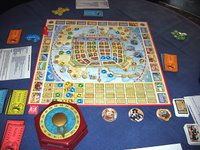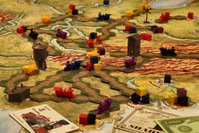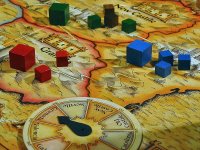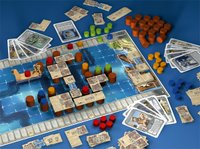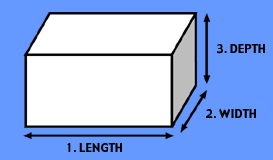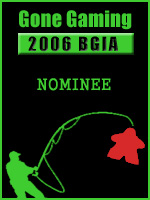Weekend Gaming
 This past weekend saw a surprising number of games hitting the table. So many, in fact, that I fell behind on my reading of the rules for Tide of Iron (Fantasy Flight Games) and Duel in the Dark (Z-Man games). More on those in a future post.
This past weekend saw a surprising number of games hitting the table. So many, in fact, that I fell behind on my reading of the rules for Tide of Iron (Fantasy Flight Games) and Duel in the Dark (Z-Man games). More on those in a future post.St. Petersburg
This is a classic for us, but it's not really shining for me any more--maybe at #50 in my ratings. At some point, the fun of the mechanics has to take a second seat to the fun of actually playing the game. This may go without saying for most people, but I do enjoy the challenge of simply "figuring things out". The strange thing is that I was wondering while playing St, Petersburg if the game Through the Ages felt anything like it: buying updates, gaining their benefits, and having these benefits feedback into future updates.
Zertz
I enjoy all the Gipf-series games. Again, I think it's the challenge "figuring things out". I haven't played any of them enough to do that, and that's fine with me. I have no interest in trying to solve any of them; I just enjoy the discovery of interesting tactical plays.
Terrace
A pretty Chess-like abstract. I've owned this game since its release in 1992. It comes out every now and then.
Ra
I hate to use the phrase "luck of the draw" with a game I rate a 10, but I feel like this is exactly the reason for my crushing 70-to-35 win. I got civ tiles and floods right when I needed them and when my opponent could not outbid me. My opponent took reasonable chances with end-of-round tiles and got hosed both times. You pays your money; you takes your chances.
Twilight Struggle
The big game of the weekend in terms of time. I had played a single turn a long time ago. We had both read the rules prior to playing. It took us 6 hours to play 8 turns (out of 10), before we had to call it. USSR was up 15 VP's. After this one game, I rate it a 6.
The rules themselves are fairly elegant, but the rulebook is only half the story. In any game with lots of unique cards that interact with each other and modify the rules, you must consider the cards themselves to be part of the rules. In the case of Twilight Struggle, this utterly destroys any pretenses of elegance. For a glimpse of this, check out this thread.
The other issue is the influence system. Insofar as individual countries are concerned, everything is great. Each country has a Stability Number, say 2, and you have to have that many more influence than your opponent to control it (the rules include another redundant condition). In addition, if your opponent does control a country, it costs 2 points to add 1 influence. This makes it easier to take control than to take control away. All great so far. However, the sheer magnitude of calculating Presence/Domination/Control over the larger regions of the board is too much. Every time you gain to lose control of an individual country, you need to be aware of the changes in control of the region. It's about the same as playing 7 simultaneous games of Tikal.
I think the game has some very good ideas that are implemented ad absurdum. I don't understand why it's so popular (but I don't care), or how anyone can play this game in less than 4 hours (unless they don't think at all about what card to play, how to use it, or where to place influence). El Grande does a much better job of giving the same kind of feel while keeping all of the elegance.
Tower of Babel
This is one of those games that forces you to turn your brain sideways, which I can never seem to manage. The one problem I have is that I always seem to offer every card I have of the chosen color. Perhaps this is strategically incorrect, but it worries me that there really aren't many interesting choices. Of course, you still have the choice of which disc to build on your turn, and whether or not to offer the trade card, but I'm worried enough that I lowered my rating a half point.
Iliad
I finally got to try this in a team game. It much better this way. The card-play is great. You not only build up your army and react to the opponents, but you also defend your partner. Figuring out who will get what benefits, how the markers will move around, and what the scores will be is still a little too heavy for the game.
King of the Elves
My first time, and maybe my last. Too much randomness and chaos for my tastes, especially for the time required.
El Grande
My second ever play of my newest favorite game. Every time I had a tough choice between 2 or more cards, I went for whatever option placed more cubes on the board, or that removed more of the opponents' cubes. I only consciously planned to compete in the Castillo during the first scoring round. Like in my first game, I led the pack for much of the way (or was very near the front), but did not win. And, again, the scores were very close (something like a high of 108 and a low of 97). I love this game.
Vegas Showdown
Brought out on a whim to fill the final hour. This game has the individual player board solitaire feeling of Alhambra with a bidding mechanism like Amun-Re or Evo. There are a lot of ways to get VP's, with some difficult choices about what action to take, what to buy, and where to place things you do buy. This is a pretty decent offering for an Avalon Hill euro game.
Phoenix
A simple and pretty game with mildly interesting choices. Mary Ann really likes it. I'm barely luke-warm on it. In my favor, the game is not available through any means that I am willing to pursue, so we can only play if I borrow a copy.
Twilight Struggle image by Chad Jensen







